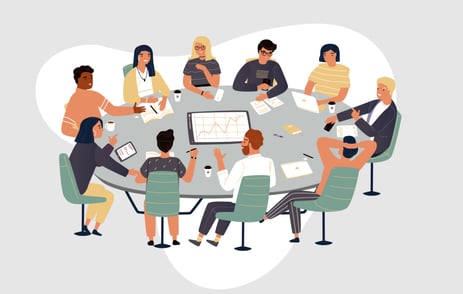And just like that, my very first ASAE Annual Meeting is in the books, and all I can say is, what an experience.
It was a pleasure to meet Sidecar members, readers and many of the association professionals I’ve been working hard to write for, for the past year. Not only did so many of you have kind things to say about our content, but also it was amazing to see, hear and learn from you in your “element.”
While this list is by no means exhaustive (it’s so tough to choose sessions even with a game plan that came from my conference planning tips!), these are some of the lessons that got the wheels turning as I look to the future content we’ll be creating at Sidecar.
1. Innovation and Failure Go Hand In Hand
The theme of ASAE 22 was “Disruption = Opportunity” – something all association professionals can relate to in light of the COVID-19 pandemic, social unrest, and the Great Resignation, among many others.
While these disruptions can be challenging in the moment, they also help organizations find creative solutions that help them move forward.
Welcome “Good Fails”
We were happy to see day 1 open with digitalNow 2021 keynote Safi Bahcall. A physicist and former public-company CEO, he’s seen his fair share of experiments. His most important call to action was for associations to not worry about failure but rather to learn how to fail successfully.
One of his prime examples was Amazon’s Fire Phone. Never heard of it? That’s because it was a failure. However, the work and research on voice recognition led to the creation of Alexa, one of Amazon’s most successful creations.
So, before waving off “crazy ideas,” Bahcall says leaders should shift from “that will never work” to “how can we create an experiment to see if it will or won't?”
“Pray for Constraints and Clarity”
For associations, the idea of doing less with more is not new. However, Day 2 keynote Marcus Whitney, investor and author, didn’t see that as a bad thing. In his own experience, dropping out of college, having a family and living in a hotel with a constant threat of eviction were adverse circumstances that provided him the clarity he needed to succeed.
In his case, this led to a push to learn to code, taking him to a career in the medtech industry where he now thrives as a healthcare VC.
For associations, there are similar opportunities. Whether it’s limited staff, budgets or time, these don’t need to be limitations. Instead, they can become opportunities for staff to improve focus and drive innovation, leading to unprecedented growth and results.
Don’t Let Failure Derail Progress
One of my favorite sessions was “Making Big Governance Moves – Reducing Bias, Increasing Diversity and Transparency” with Veronica Meadows, Chief Strategy Officer, and Andrea Elkin, PMO Manager, of the Council of Landscape Architectural Registration Boards.
Their organization struggled with its leadership pipeline and a shrinking pool of candidates for its board of directors. However, when deciding how to make a change, they were also faced with getting member buy-in and existing “traditions” and governance.
After an initial failed bylaws vote (by a small margin), they refocused on creating a member acceptance strategy. From changing the messaging to focus more on member gains to empowering leaders to become ambassadors for the change, they took the failure as an opportunity to learn and prepare for the future.
A year later, they implemented the changes and now have a more diverse board with increased nominations, particularly those with diverse backgrounds.
2. Building Culture Takes Intentionality and Strategy
In her Catalyst session “Generation, Racial Equity & Their Intersection,” Raven Solomon, global diversity, equity and inclusion thought leader, explained the importance of real inclusivity with a Verna Myers quote: “Diversity is being invited to the party; inclusion is being asked to dance.”
As more organizations take strides toward their DEI efforts, it’s essential to understand that strategy and intentionality are just as important as identifying the problem.
The Intersection of Generations and Racial Equity
Another important takeaway from Solomon’s session was outlining the different generational differences that exist in the workplace. It was a common thread in many discussions and sessions throughout the conference.
For the first time ever, we have Baby Boomers, Generation X, Millennials and now Generation Z working side by side. Not only does this lead to the chances of misunderstandings and friction, particularly on hot-button issues, but what the staffer needs from their organization differ too.
As Solomon puts it, the actual definition of diversity is the presence of difference. Understanding these differences and opening lines of communication is just as crucial to your DEI effort and can help create more opportunities for inclusion and equity.
Understanding Your Association’s Power Dynamics
Not only have societal challenges shifted the focus for organizations, but also they have impacted the power dynamic within them. In the session “Shifting Power Dynamics: Finding Strength & Balance in Your Association,” Lowell Applebaum, CEO of Vista Cova, and Debra McGuire, Executive Director of the International Association of Assessing Officers, tackled many of these changes.
From precipitating incidents like the pandemic to momentary shifts in power that changed an organization's governance, power has quickly and easily changed hands more than ever. Not only can this lead to conflicts, but it can also prevent an association from achieving its mission in many cases.
Their presentation focused on the importance of being intentional about power. Being clear and concise on where those dynamics exist, putting checks and balances in place to protect against significant shifts and creating transparency to point out power dynamic concerns are critical.
“The luck of the draw is not lucky,” they said, and without any attention and care, the power structure in an organization will happen by happenstance, not by intention.
3. Successful Membership Starts with Your Organization
As an association, the main goal is to provide as much value as possible to your membership and industry. However, many organizations forget that they’re also service-based organizations – meaning understanding the needs and interests of members is essential.
Do Potential Members Know What You Do?
In most cases, your website will be your first introduction to potential members. Yet, many organizations struggle with poorly designed sites or focus too much on content and information that doesn't truly resonate with their visitors.
While you can quickly go down a rabbit hole of conducting content audits and website redesigns, one more straightforward place to start is with the five-second test.
In her session “The Power of Iteration: Fix Fixes to Improve Website Engagement,” Rachel Clemens, Chief Marketing Officer of Mighty Citizen, pointed out that potential members need to know “what service you do, who you serve and how they can participate” within five seconds of landing on your website.
In many cases, a few simple edits can make a significant difference in website conversion.
What Does Member Success Look Like Today?
With powerhouses like Amazon and Netflix, your members have become accustomed to having their needs met quickly and efficiently. Those expectations extend to every aspect of their lives, including their association membership.
One of the most important ways to do this is with member onboarding. While many organizations have some type of welcome letter for new members, the process needs to be more than just an afterthought.
In her session, “Love ‘em or Lose ‘em! Onboarding with Intention for Retention,” Jennifer Norma, VP of Customer Growth for Novi AMS, outlined a much more thorough process. Not only should you be integrating welcome letters, but using tools like videos from your CEO, handwriting notes or postcards, and for a bit of a throwback, a literal phone call!
The point is elevating your member experience to emulate the expectations that unconsciously exist from their daily experience.
Your Role In Sidecar’s Content
Since starting in 2021, my goal as content manager has been to create valuable and informational content. I’m proud of many of the stories we’ve been able to tell and my experience at ASAE 22 reinforces the importance of your voice, insights and lessons to our content strategy.
While I’m sure many of you will hear from me soon – look out for that LinkedIn request – I also want this to be a call to our community at large.
Yes, we’re creating content for you, but we also want to create content with you.
Whether you’re interested in joining us as a contributor, have a great story you’d like to share or have someone you think it’s imperative gets in the spotlight, at Sidecar, we’re all about it.
Our mission is to grow leaders at every level, and to do that, we need to meet, share and contribute with all the leaders and professionals I was lucky to see this past weekend.
Tags:
Association Management
August 25, 2022


